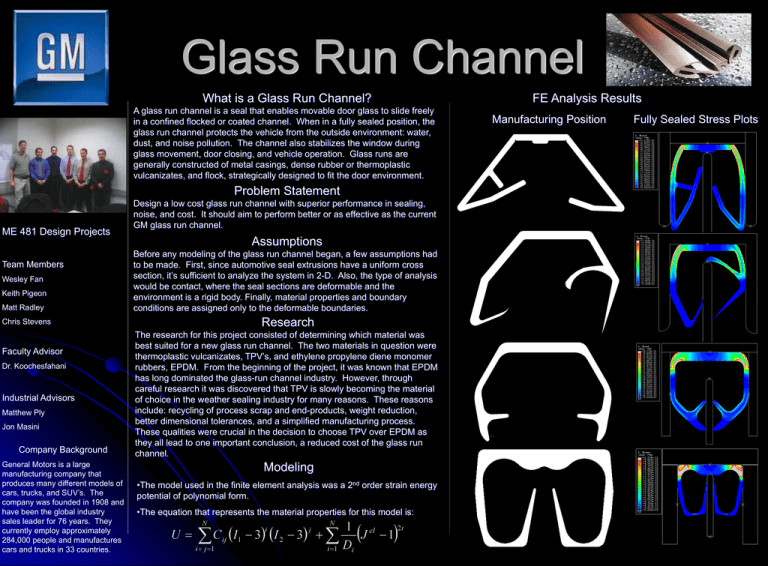Poster8.ppt
advertisement

U N N Cij I1 3 I 2 3 i j 1 i j i 1 2i 1 el J 1 Di Glass Run Channel What is a Glass Run Channel? A glass run channel is a seal that enables movable door glass to slide freely in a confined flocked or coated channel. When in a fully sealed position, the glass run channel protects the vehicle from the outside environment: water, dust, and noise pollution. The channel also stabilizes the window during glass movement, door closing, and vehicle operation. Glass runs are generally constructed of metal casings, dense rubber or thermoplastic vulcanizates, and flock, strategically designed to fit the door environment. Problem Statement ME 481 Design Projects Team Members Wesley Fan Keith Pigeon Matt Radley Chris Stevens Faculty Advisor Dr. Koochesfahani Industrial Advisors Matthew Ply Jon Masini Company Background General Motors is a large manufacturing company that produces many different models of cars, trucks, and SUV’s. The company was founded in 1908 and have been the global industry sales leader for 76 years. They currently employ approximately 284,000 people and manufactures cars and trucks in 33 countries. Design a low cost glass run channel with superior performance in sealing, noise, and cost. It should aim to perform better or as effective as the current GM glass run channel. Assumptions Before any modeling of the glass run channel began, a few assumptions had to be made. First, since automotive seal extrusions have a uniform cross section, it’s sufficient to analyze the system in 2-D. Also, the type of analysis would be contact, where the seal sections are deformable and the environment is a rigid body. Finally, material properties and boundary conditions are assigned only to the deformable boundaries. Research The research for this project consisted of determining which material was best suited for a new glass run channel. The two materials in question were thermoplastic vulcanizates, TPV’s, and ethylene propylene diene monomer rubbers, EPDM. From the beginning of the project, it was known that EPDM has long dominated the glass-run channel industry. However, through careful research it was discovered that TPV is slowly becoming the material of choice in the weather sealing industry for many reasons. These reasons include: recycling of process scrap and end-products, weight reduction, better dimensional tolerances, and a simplified manufacturing process. These qualities were crucial in the decision to choose TPV over EPDM as they all lead to one important conclusion, a reduced cost of the glass run channel. Modeling •The model used in the finite element analysis was a 2nd order strain energy potential of polynomial form. •The equation that represents the material properties for this model is: FE Analysis Results Manufacturing Position Fully Sealed Stress Plots



